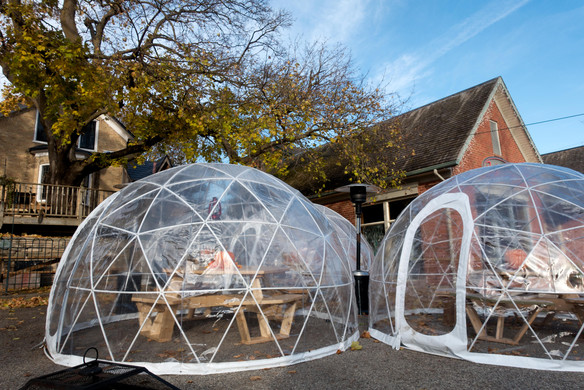Table of contents
With COVID-19 concerns creating restrictions on indoor dining, restaurateurs have been focused on keeping their restaurants open and keeping customers coming to their establishments. Outdoor dining has been one of the most popular ways for restaurants to continue serving patrons throughout the pandemic. In New York City, for example, nearly 11,000 restaurants are participating in the city’s Open Restaurants initiative.
As part of the shift to outdoor dining, many restaurant owners have taken an interest in outdoor dining bubbles. Outdoor dining bubbles, also known as bubble tents or dining pods, offer restaurants a way to serve patrons in private, enclosed spaces outside their restaurant walls. These spaces range from sidewalks to parking lanes.
While these eye-catching structures may help some restaurants attract customers, and keep them warm in the colder months, they come with certain risks. Before investing in outdoor bubbles for your establishment, here are the pros, cons, and other considerations to know before building your own bubbles.
Types of outdoor dining bubbles
Enclosed outdoor structures provide a unique experience for diners and can be an attention-grabbing marketing tactic for attracting customers in the colder months. They also provide restaurants an alternative to building pavilion-like structures to house patrons for outdoor dining.
Types of dining bubbles include:
- Clear plastic zip-up tents that can house tables for up to six diners at once
- Large, see-through geodesic domes which also house tables for up to six diners at once
- Glass greenhouses that provide seating for two to four diners at a time
- Yurts made of wood and covered with fabric, which come in various sizes (some of which are large enough to house multiple tables)
The benefits of outdoor dining bubbles
Dining bubbles enable restaurants to continue serving patrons outside all year, even in adverse conditions like rain or snow. This helps business owners maintain in-person dining options during times indoor dining is allowable only at a limited capacity or not allowed at all.
The most popular dining bubbles and domes have vents at the top for airflow, but are otherwise designed to keep customers warm. Depending on bubble type and ordinances by location, some restaurant owners can also put space heaters inside their bubbles to further help customers stay warm in colder temperatures.
Helping customers keep their distance from each other is another benefit. Bubbles limit contact between patrons of different parties while helping limit those parties to six diners or less. If the bubble is especially large, all members of a party can even sit at safe social distances from one another inside the enclosure.
Restaurants can also use the nature of bubbles to craft smart strategies for limiting contact between diners and employees. Mediamatic ETEN, a Dutch restaurant that offers service in greenhouses, for example, serves food to patrons on long wooden boards so that waitstaff doesn’t need to enter the enclosure.
The challenges of outdoor dining bubbles
No matter how they serve food, however, restaurants need to deploy many additional measures to ensure that dining-bubble dining is safe for patrons. And no matter how well-executed a dining-bubble concept is, it’s not wise for any restaurateur to view them as a lifeline for the coming months.
Despite how comfortable the in-bubble conditions may be in terms of temperature, not all customers will be comfortable dining inside them during a pandemic.
Generally, bubbles pose the same COVID-19 risks as indoor dining (which one CDC study pinpointed as an especially high-risk activity). There’s not the same level of air exchange in a dining bubble as there is in an open-air experience, with a potentially high risk of transmission if you occupy the same bubble as someone with COVID-19.
And because the droplets that people produce when talking, breathing, and eating can easily build up inside a bubble, enhanced cleaning measures are required. Staff must enter and sanitize a bubble in between parties; this not only limits how many parties can be seated and served in a given night, but also creates risk for the employees tasked with cleaning the enclosures.
There’s a reputational risk at play for the restaurant, as well, in the event that COVID-19 transmission takes place at the establishment or if the bubbles are poorly received by the local community. Some San Francisco restaurants have received backlash, for example, for serving high-end and expensive meals in domed enclosures in neighborhoods afflicted with severe homelessness problems.
Dining bubbles are also not universally allowed across the US. In Connecticut, for example, the structures are currently completely prohibited.
Breaking down the cost
Individual dining pods, depending on size, currently range from around $470 for a 10-foot by 10-foot enclosure to $790 for a 15-foot by 15-foot bubble. Larger, upscale geodesic domes can run upward of $1,449, each, and ready-to-go yurts can cost between $2,400 for a 12-foot structure to $4,300 for a 20-foot one.
The more customized the structures, the higher the price. Those prices don’t reflect the added and ongoing costs associated with setting up and maintaining the pods, either. These include the expenses for permits, enhanced cleaning, nightly set-up and tear-down, heating, insurance, furniture and lighting for inside as well as outside the pods.
Researching and applying for permits, and understanding what is allowed by location, also requires significant time investment. Insurance can also be a significant expense; obtaining a San Francisco permit, for example, requires the restaurant to maintain general liability insurance throughout the term of the permit in the amount of at least $1,000,000 per occurrence and up to $2,000,000 in the aggregate to respond to any claims made against the City and County of San Francisco related to the use of sidewalk or parking lane space.
The peculiarities of the pods also create costs that are hard to assess in advance of utilizing them on-site.
Heating is one such peculiarity. In some locations, only electrical space heaters are allowed; in others, you can opt for electric or gas heating (and there are separate, specific requirements for permitting depending on which utilities you use). If you opt to heat the pods at all, you may spend quite a lot on heat as it will be expended through the required ventilation systems: In Chicago, temporary outdoor structures have to keep 50% of their sides open for air flow. They also must be weighted or anchored to the ground, be made of certified fire-resistant material, and any heating equipment needs to meet specific regulations.
There’s also the potential lost revenue of turning fewer tables each night as the bubbles absorb time and effort from staff, as well as the expense of any PPE and specialized serving utensils designed to get food or drinks to patrons safely. Food typically cannot be prepared inside an enclosed outdoor dining structure, so the equipment necessary to keep food hot may be an additional unexpected expense.
An uncertain outdoor dining solution
Since it’s hard to estimate the costs upfront, restaurateurs investing in dining bubbles have to be comfortable with uncertainty.
“You’re buying all this stuff, you’re in the process of trying to see if it’s working or not but you don’t have the time or finances to really be able to afford options,” Square seller Leyla Khanahmad, of The Black & Caspian in Chicago, told us. Her experience with dining bubbles found them to be “great for the customers, but not great for the restaurants because bubble dining really limits your capacity to only a few tables per night per shift.”
Her team decided to get rid of bubbles and instead build a large heated patio that’s sturdy enough to endure the Chicago winter.
And as great as customers may find dining bubbles to be, they still pose high risks of COVID-19 transmission among diners in the same bubble. Leaving the vents open makes them safer than a fully zipped tent, but may make them less comfortable for customers in the cold months of the year.
![]()











